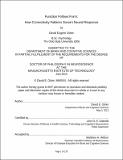Function follows form : how connectivity patterns govern neural responses
Author(s)
Osher, David Eugene
DownloadFull printable version (3.668Mb)
Other Contributors
Massachusetts Institute of Technology. Department of Brain and Cognitive Sciences.
Advisor
John D. E. Gabrieli.
Terms of use
Metadata
Show full item recordAbstract
Connectivity restricts and defines the information that a network can process. It is the substance of information processing that underlies the patterns of functional activity in the brain. By combining diffusion-weighted imaging or DWI, with fMRI, we are able to non-invasively measure connectivity and neural responses in the same individuals and directly relate these two measures to one another. In Chapter 2, I first establish the proof-of-principle that anatomical connectivity alone can predict neural responses in cortex, specifically of face-selectivity in the fusiform gyrus. I then extend this novel approach to the rest of the brain and test whether connectivity can accurately predict neural responses to various visual categories in Chapter 3. Finally, in Chapter 4, I compare and contrast the resulting models, which are essentially networks of connectivity that are functionally-relevant to each visual category, and demonstrate the type of knowledge that can be uncovered by directly integrating structure and function.
Description
Thesis (Ph. D. in Neuroscience)--Massachusetts Institute of Technology, Dept. of Brain and Cognitive Sciences, 2013. This electronic version was submitted by the student author. The certified thesis is available in the Institute Archives and Special Collections. Cataloged from student-submitted PDF version of thesis. Includes bibliographical references.
Date issued
2013Department
Massachusetts Institute of Technology. Department of Brain and Cognitive SciencesPublisher
Massachusetts Institute of Technology
Keywords
Brain and Cognitive Sciences.